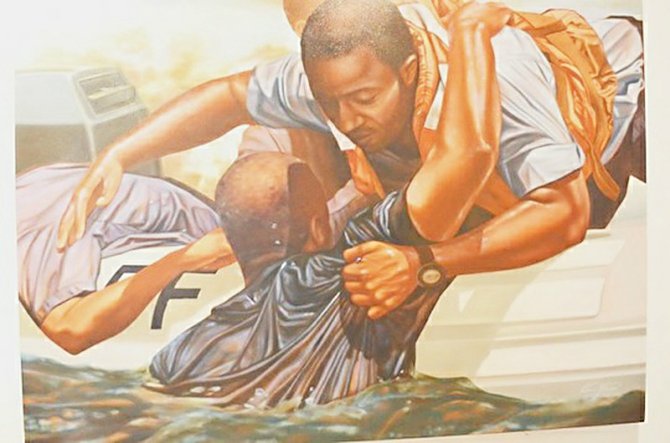By Rupert Missick Jr
MIDWAY through his wildly successful and groundbreaking exhibition at The National Art Gallery of the Bahamas entitled “Swan Song of the Flamingo”, Kishan Munroe says he was not surprised by the warm reception that the exhibition has received over the past two months.
Munroe said that he always had full faith that the Bahamian public, once given accurate information in a responsible, palatable manner, would respond positively. “Swan Song of the Flamingo” is a collaborative project that marries Munroe’s visual artistry with the work of other Bahamian and Cuban artists from various disciplines to create a boundary shattering programme that shines a spotlight on a painful period in Bahamian history: the sinking of HMBS Flamingo of the Royal Bahamas Defence Force fleet on May 10, 1980.
“This is something that the nation has been in need of for a while now: real acts of change (sociopolitical) from its artists on a national level, to deal with historic issues that affect us even until today.
“Deep down inside we want to know... we want to learn… who we are… what we really are. We have a burning desire to find our true selves and be able to truly define ourselves as Independent Bahamians,” Munroe said.
The exhibition received the full support of the Royal Bahamas Defence Force, including surviving marines from the Flamingo incident. Munroe said that this endorsement and to hear that the project moved them emotionally, was the first sign of the project’s success.
“I had the privilege of interviewing Oscar ‘Dusty’ Miller several times before his untimely death only days after the opening of the exhibit at the National Art Gallery. I went to his memorial and saw that his family had placed my name under the ‘friends and family’ section. I was also publicly recognised at his memorial by the Commodore of the Defence Force, Roderick Bowe.
“This moved me tremendously, knowing that I met a man only briefly but what I did with him… for him, through the process of the interviews I conducted, his family felt warranted placing me in that intimate category. The story of the Flamingo Incident was something that was dear to him and he was able to finally share it with me just before he passed away.
“The fact that I was able to record his story of those traumatic series of events so that the significance of his sacrifice is acknowledged was a great accomplishment for me,” Munroe said.
Munroe approached both the Cuban and Bahamian governments, explaining that he intended for the project to foster a broader dialogue between the nations and their leaders and citizens alike.
For almost three years, Munroe travelled between both countries engaging in dialogue with embassies, government officials and those affected by the tragedy.
He said that the process gave him greater appreciation for the diplomacy of “not only politics but also our everyday relationships”.
“Since the opening of the show I think that both governments have been pleased with the results. This project is not just about conflict, rather it is designed to bring about reconciliation through awareness,” Munroe said.
Dialogue about the Flamingo incident has been going on strong in the Bahamas for a few months now.
Political figures and laymen alike have enthusiastically debated the nuances and context of the situation.
Since the opening of the show Munroe has received many letters of appreciation from esteemed members of society (government and other public figures) commending him for his devotion to the project over the many years of research, and the sensitivity with which the potentially volatile issue was handled.
Many now consider the collection to be of historic and national significance.
For his part, Munroe believes that this event will never disappear from the consciousness of the general Bahamian public.
“The works that were created as a part of this project were crafted to ensure enlightenment and the cultivation of critical analysis for future generations. Those who have forgotten will be reminded. Those who never knew will be taught,” Munroe said.
After the exhibit at the National Art Gallery closes, Munroe hopes to see the project evolving to further spark an international dialogue.
“I would like to see the artworks remain as a cohesive body in a permanent home where the entire story can be absorbed by viewers,” he said.
Kishan is the youngest artist to be granted a solo exhibition at The National Art Gallery of The Bahamas. “Swan Song of the Flamingo” closes on March 16.





Comments
Use the comment form below to begin a discussion about this content.
Sign in to comment
Or login with:
OpenID